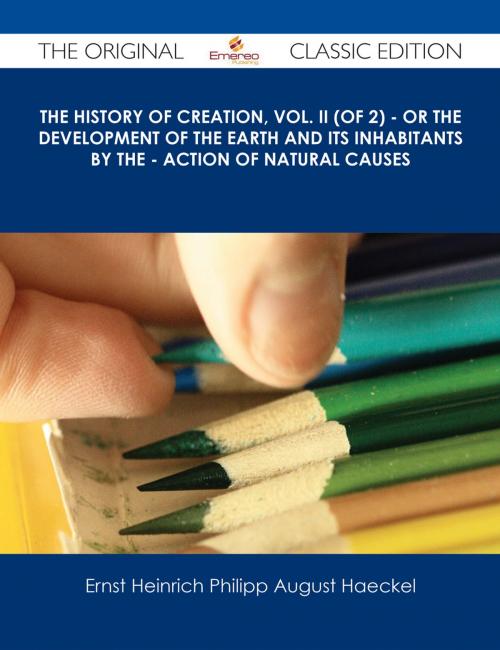The History of Creation, Vol. II (of 2) - Or the Development of the Earth and its Inhabitants by the - Action of Natural Causes - The Original Classic Edition
Nonfiction, Reference & Language, Reference, Fiction & Literature| Author: | Ernst Heinrich Philipp August Haeckel | ISBN: | 9781486447435 |
| Publisher: | Emereo Publishing | Publication: | March 18, 2013 |
| Imprint: | Emereo Publishing | Language: | English |
| Author: | Ernst Heinrich Philipp August Haeckel |
| ISBN: | 9781486447435 |
| Publisher: | Emereo Publishing |
| Publication: | March 18, 2013 |
| Imprint: | Emereo Publishing |
| Language: | English |
Finally available, a high quality book of the original classic edition of The History of Creation, Vol. II (of 2) - Or the Development of the Earth and its Inhabitants by the - Action of Natural Causes. It was previously published by other bona fide publishers, and is now, after many years, back in print.
This is a new and freshly published edition of this culturally important work by Ernst Heinrich Philipp August Haeckel, which is now, at last, again available to you.
Get the PDF and EPUB NOW as well. Included in your purchase you have The History of Creation, Vol. II (of 2) - Or the Development of the Earth and its Inhabitants by the - Action of Natural Causes in EPUB AND PDF format to read on any tablet, eReader, desktop, laptop or smartphone simultaneous - Get it NOW.
Enjoy this classic work today. These selected paragraphs distill the contents and give you a quick look inside The History of Creation, Vol. II (of 2) - Or the Development of the Earth and its Inhabitants by the - Action of Natural Causes:
Look inside the book:
Reform of Systems by the Theory of Descent.—The Natural System as a Pedigree.—Palæontological Records of the Pedigree.—Petrifactions as Records of Creation.—Deposits of the Neptunic Strata and the Enclosure of Organic Remains.—Division of the Organic History of the Earth into Five Main Periods: Period of the Tangle Forests, Fern Forests, Pine Forests, Foliaceous Forests, and of Cultivation.—The Series of Neptunic Strata.—Immeasurable Duration of the Periods which have elapsed during their Formation.—Deposits of Strata only during the Sinking, not during the Elevation of the Ground.—Other Gaps in the Records of Creation.—Metamorphic Condition of the most Ancient Neptunic Strata.—Small Extent of Palæontological Experience.—Small proportion of Organisms and of Parts of Organisms Capable of Petrifying.—Rarity of many Petrified Species.—Want of Fossilised Intermediate Forms.—Records of the Creation in Ontogeny and in Comparative Anatomy 1 ...Reform of Systems by the Theory of Descent.—The Natural System as a Pedigree.—Palæontological Records of the Pedigree.—Petrifactions as Records of Creation.—Deposits of the Neptunic Strata and the Enclosure of Organic Remains.—Division of the Organic History of the Earth into Five Main Periods: Period of the Tangle Forests, Fern Forests, Pine Forests, Foliaceous Forests, and of Cultivation.—The Series of Neptunic Strata.—Immeasurable Duration of the Periods which have elapsed during their Formation.—Deposits of Strata only during the Sinking, not during the Elevation of the Ground.—Other Gaps in the Records of Creation.—Metamorphic Condition of the most Ancient Neptunic Strata.—Small Extent of Palæontological Experience.—Small proportion of Organisms and of Parts of Organisms Capable of Petrifying.—Rarity of many Petrified Species.—Want of Fossilised Intermediate Forms.—Records of the Creation in Ontogeny and in Comparative Anatomy. ...The average thickness of all the four other rock groups, the primary, secondary, tertiary, and quaternary, taken together, may amount at most to 60,000 feet; and from this fact alone, apart from many other reasons, it is evident that the duration of the primordial period was probably much longer than the duration of all the subsequent periods down to the present day.
About Ernst Heinrich Philipp August Haeckel, the Author:
It was agreed by all European evolutionists that all vertebrates looked very similar at an early stage, in what was thought of as a common ideal type, but there was a continuing debate from the 1820s between the Romantic recapitulation theory that human embryos developed through stages of the forms of all the major groups of adult animals, literally manifesting a sequence of organisms on a linear chain of being, and Karl Ernst von Baer's opposing view that the early general forms diverged into four major groups of specialised forms without ever resembling the adult of another species,
Finally available, a high quality book of the original classic edition of The History of Creation, Vol. II (of 2) - Or the Development of the Earth and its Inhabitants by the - Action of Natural Causes. It was previously published by other bona fide publishers, and is now, after many years, back in print.
This is a new and freshly published edition of this culturally important work by Ernst Heinrich Philipp August Haeckel, which is now, at last, again available to you.
Get the PDF and EPUB NOW as well. Included in your purchase you have The History of Creation, Vol. II (of 2) - Or the Development of the Earth and its Inhabitants by the - Action of Natural Causes in EPUB AND PDF format to read on any tablet, eReader, desktop, laptop or smartphone simultaneous - Get it NOW.
Enjoy this classic work today. These selected paragraphs distill the contents and give you a quick look inside The History of Creation, Vol. II (of 2) - Or the Development of the Earth and its Inhabitants by the - Action of Natural Causes:
Look inside the book:
Reform of Systems by the Theory of Descent.—The Natural System as a Pedigree.—Palæontological Records of the Pedigree.—Petrifactions as Records of Creation.—Deposits of the Neptunic Strata and the Enclosure of Organic Remains.—Division of the Organic History of the Earth into Five Main Periods: Period of the Tangle Forests, Fern Forests, Pine Forests, Foliaceous Forests, and of Cultivation.—The Series of Neptunic Strata.—Immeasurable Duration of the Periods which have elapsed during their Formation.—Deposits of Strata only during the Sinking, not during the Elevation of the Ground.—Other Gaps in the Records of Creation.—Metamorphic Condition of the most Ancient Neptunic Strata.—Small Extent of Palæontological Experience.—Small proportion of Organisms and of Parts of Organisms Capable of Petrifying.—Rarity of many Petrified Species.—Want of Fossilised Intermediate Forms.—Records of the Creation in Ontogeny and in Comparative Anatomy 1 ...Reform of Systems by the Theory of Descent.—The Natural System as a Pedigree.—Palæontological Records of the Pedigree.—Petrifactions as Records of Creation.—Deposits of the Neptunic Strata and the Enclosure of Organic Remains.—Division of the Organic History of the Earth into Five Main Periods: Period of the Tangle Forests, Fern Forests, Pine Forests, Foliaceous Forests, and of Cultivation.—The Series of Neptunic Strata.—Immeasurable Duration of the Periods which have elapsed during their Formation.—Deposits of Strata only during the Sinking, not during the Elevation of the Ground.—Other Gaps in the Records of Creation.—Metamorphic Condition of the most Ancient Neptunic Strata.—Small Extent of Palæontological Experience.—Small proportion of Organisms and of Parts of Organisms Capable of Petrifying.—Rarity of many Petrified Species.—Want of Fossilised Intermediate Forms.—Records of the Creation in Ontogeny and in Comparative Anatomy. ...The average thickness of all the four other rock groups, the primary, secondary, tertiary, and quaternary, taken together, may amount at most to 60,000 feet; and from this fact alone, apart from many other reasons, it is evident that the duration of the primordial period was probably much longer than the duration of all the subsequent periods down to the present day.
About Ernst Heinrich Philipp August Haeckel, the Author:
It was agreed by all European evolutionists that all vertebrates looked very similar at an early stage, in what was thought of as a common ideal type, but there was a continuing debate from the 1820s between the Romantic recapitulation theory that human embryos developed through stages of the forms of all the major groups of adult animals, literally manifesting a sequence of organisms on a linear chain of being, and Karl Ernst von Baer's opposing view that the early general forms diverged into four major groups of specialised forms without ever resembling the adult of another species,















